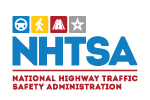 |
 |
Small Overlap / Oblique Crashes
 |
| |
Studies show that fatalities still happen with vehicles equipped with safety belts and airbags in both small overlap and oblique crashes. Small overlap crashes are crashes with all the damage outside the main longitudinal member. Oblique crashes engage one of the main longitudinal member and cause the occupant to move in an oblique manner. Therefore, the agency is trying to develop test procedure to reduce fatalities and injuries in these two crash modes. |
| |
 |
Small Overlap / Oblique Program |
 |
|
|
|
 |
 |
Child Safety
 |
| |
Studies and reports provide an overview of the progress of child safety in the United States. This provides a summary of NHTSA's activities in promoting child safety, summarizes the agency's regulatory actions, and discusses issues regarding obstacles in the wide-spread use of booster seats. |
| |
 |
Child Safety Research |
 |
|
|
|
 |
 |
Alternative Energy
 |
|
Ensuring that alternative fuel vehicles attain a level of safety comparable to that of other vehicles requires extensive research, due to the many advanced and unique technologies that have previously not been tested in the transportation environment. |
| |
 |
Alternative Energy Research |
 |
|
|
|
 |
 |
Heavy Trucks
 |
| |
Heavy Truck safety is focused on occupant safety and underride guards. Heavy truck occupant safety examines the causes of fatality and injury for heavy truck occupants, while truck underride research identifies the characteristics of underride events and contributing factors. |
| |
 |
Truck Underride |
| |
 |
Truck Occupant Safety |
 |
|
|
|
 |
 |
Rollover
 |
| |
The goal of the Agency's continuing research is to understand the vehicle and occupant kinematics pursuant to rollover initiation. Further, pre-crash elements might serve as important input parameters for the rollover crash reconstruction models. |
| |
 |
Rollover Research |
 |
|
|
|
 |
 |
School Bus
 |
| |
Due to regulations requiring compartmentalization on large school buses, American students are safer riding in a school bus than they are riding in a car. NHTSA is committed to ensuring the safety of our Nation's children in school buses. |
| |
 |
School Bus Crashworthiness Research |
 |
|
|
|
|
|
|
|
|
 |
 |
Aggressivity and Fleet Compatibility
 |
| |
The purpose of this research program is to investigate the problems of vehicle aggressivity and compatibility in multi-vehicle crashes. The near-term goal is to identify and demonstrate the extent of the problem of incompatible vehicles in vehicle-to-vehicle collisions. |
| |
 |
Vehicle Aggressivity and Fleet Compatibility Research |
 |
|
|
|
|
|

